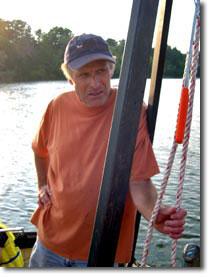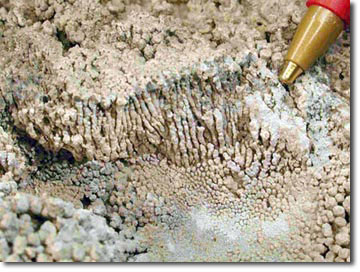Research
Interests
Arctic
Paleohydrology • Permafrost
Hydrogeology • 129I in
Groundwaters • Mine Hydrogeology • Noble
Gases in Groundwaters • Groundwaters
in Arid Regions
 My research interests
revolve around the use of environmental isotopes and
geochemistry in groundwater and paleoclimate studies.
Stable isotopes, measured at the natural abundance
levels found in nature, are tracers of water, solutes
and gases. Together with geochemical tools, we can
look at the recharge origin of groundwaters, and the
biogeochemical processes that occured in the subsurface.
Applications of these methods range from water resources
and groundwater contamination to paleoclimatology.
My research interests
revolve around the use of environmental isotopes and
geochemistry in groundwater and paleoclimate studies.
Stable isotopes, measured at the natural abundance
levels found in nature, are tracers of water, solutes
and gases. Together with geochemical tools, we can
look at the recharge origin of groundwaters, and the
biogeochemical processes that occured in the subsurface.
Applications of these methods range from water resources
and groundwater contamination to paleoclimatology.
1) Arctic Paleohydrogeology
Work in the karst
regions of the Yukon led to the discovery by Bernard
Lauriol and myself of this remarkable material
forming in fissures within limestone outcrops.
Endostromatolites, so named for their micro-stromatilite
structure and hidden growth within bedrock, are
ubiquitous in permafrost carbonate regions. They
form by bacterial activity involving the degradation
of soil organics and production of methane, leaving
an unusual isotopic signature. of I work with Bernard
Lauriol in the Department of Geography. Our work
to date has focussed on Endostromatolites: Hand
specimen of a fissure surface with endostromatolite
columns. Photo is about 10 cm wide. Columns are
about 1 cm tall.

Endostromatolite
is a previously undescribed biogenic calcrete that
lines fissures in carbonate terrains throughout
non-glaciated permafrost regions. This material
is found in fissures to depths of up to 5 meters
from modern bedrock surfaces, and has precipitated
from groundwaters under closed system, anoxic conditions.
We believe that the material documents periods
of expanded talik and deepened permafrost due to
increased summer warmth in the Arctic.
See: Clark,
Lauriol, Marschner, Nicolas, Charet and Desrochers, 2004.
Canadian Journal of Earth Sciences. PDF File
back
to top
2) Permafrost hydrogeology
and Canadian Shield mine hydrology
The movement
of groundwater in permafrost is of interest to
understand the extent and permeability of permafrost,
as well as the timing of recharge in permafrost
regions.
We are now looking
at groundwater recharge and circulation in permafrost,
through the analysis of noble gas concentrations
and other isotopic tools. The long term disposal
of radioactive waste must consider the effects of
climate change and renewed glaciation on the repository
and nuclide transport.
back
to top
3) The movement of 129I
in groundwaters
Iodine-129
is one of the nuclear reactor waste products
of greatest concern. It is a fission product
that is readily leached from spent fuel, and
poses considerable radiological hazard due to
its affinity for concentration in the thyroid
gland. Its migration from a nuclear waste repository
is of concern considering its relatively high
mobility in natural groundwaters (the repository
far-field). The Canadian Nuclear Safety Commission
have funded this project in collaboration with
Drs. Tom Kotzer (Canadian Light Source, University
of Saskatoon) and Gwen Milton formerly with Atomic
Energy of Canada Ltd. (AECL). Phase I focused
on the high concentrations of 129I at the Chalk
River Nuclear Laboratories site in Eastern Ontario.
This was published by MSc student Nicholas Alvarado
Quiroz in Radiochimica
Acta (Alverado).
The project has had a second phase, looking at
I-129 in the natural setting of the Sturgeon Falls,
Ontario, site. Rob Renaud (now with AECL Chalk
River) and his thesis is now published, also in Radiochimica
Acta (Renaud).
back
to top
4) Mine Hydrogeology:
Analogues for groundwater flow at a nuclear waste repository
We are
now looking at groundwater recharge and circulation
in permafrost, through the analysis of noble
gas concentrations and other isotopic tools.
The long term disposal of radioactive waste must
consider the effects of climate change and renewed
glaciation on the repository and nuclide transport.
Recent publications on this include Douglas et
al., Journal
of Hydrology, 235:88-103, and Clark et al.,
Ground Water, 38: 735-742.
back
to top
5) Noble gases in groundwaters
Nick Battye (Co-supervised
with Tom Kotzer) undertook his MSc project looking
at noble gas concentrations in groundwaters from
the Con Mine, Yellowknife. This work uses the concentrations
of He, Ne, Ar, Kr and Xe to determine the temperature
of recharge in shallow groundwaters, and the age
of the brines found at greater depth. The former
is based on the temperature-dependency of noble
gas solubility, which provides a thermometer, set
at the moment of recharge. In contrast, the deep
brines have accumulated He and Ar over geological
time periods, generated through alpha decay of
U and Th (for 4He) and 40K decay (for 40Ar). In
a second phase of the project, Shane Greene (MSc
student) has developed a diffusion sampler (seen
in picture above) to complement water samples for
noble gases in mines.
back
to top
6) Groundwaters in Arid
Regions
I continue research
into the age and origin of groundwaters in arid
regions, principally through collaboration with
Dr. Hani Khoury and Dr. Elias Salameh at the University
of Jordan in Amman. We have been studying groundwaters
in the northern regions of Jordan, particularly
in the Maqarin region, where groundwaters with
pH up to 12.5 discharge from natural, metamorphic
zones in marl where combustion in the past has
created natural cement-kilns. This is part of an
international Radioactive Waste Disposal Analogue
program involving SKB (Sweden), NIREX (UK) and
Nagra (Switzerland). We are learning about the
behaviour of safety-relevant nuclides in cementitious
environments through studies of the Maqarin (Jordan)
high pH analogue site.
back
to top
